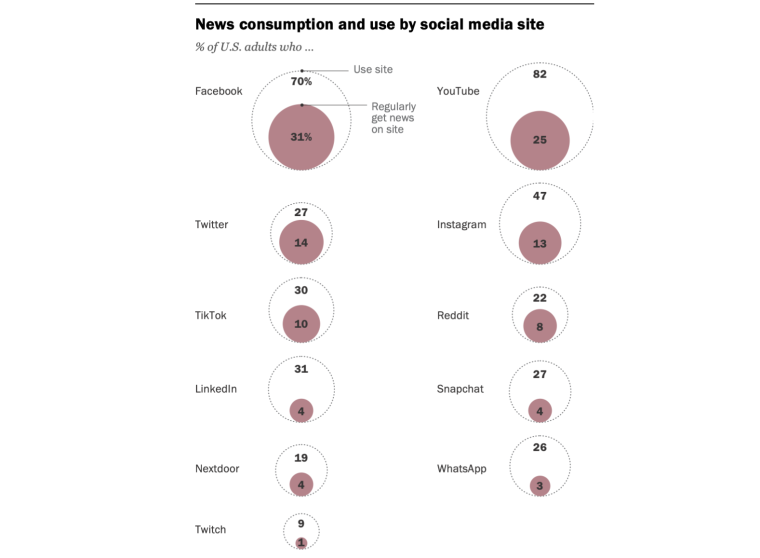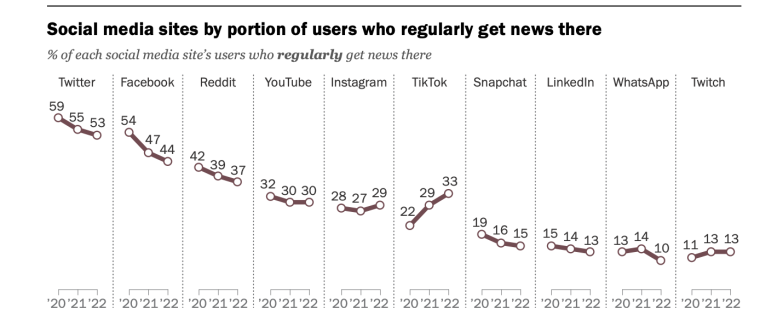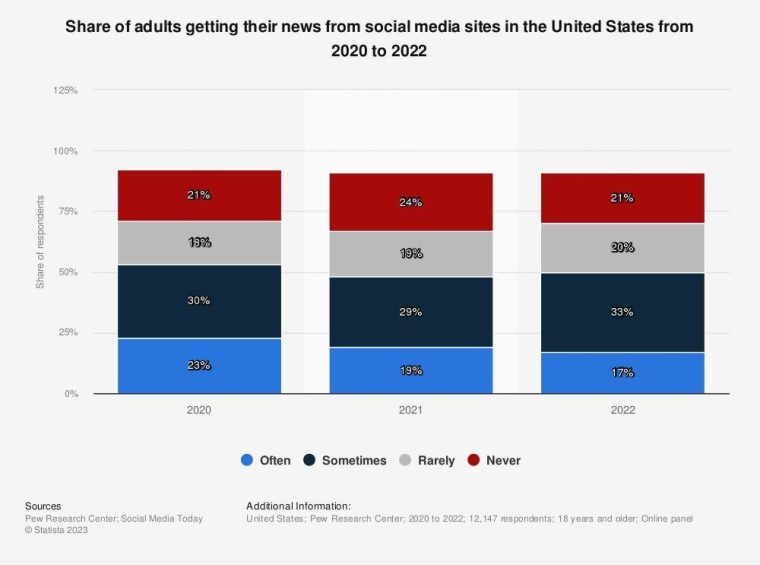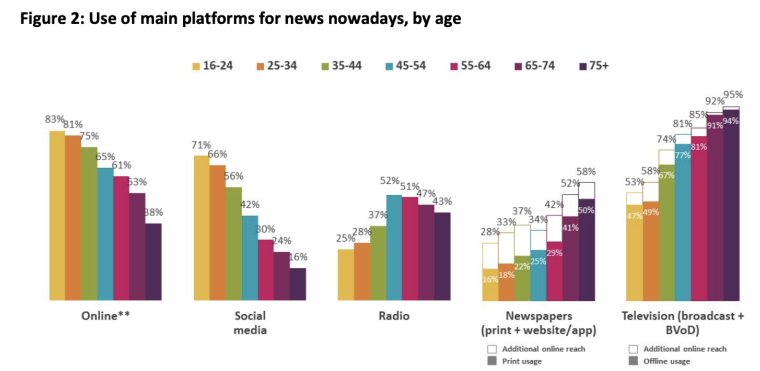
Digital news has become the new norm for media outlets. However, research indicates almost half of U.S. young adults rely on social media to keep up with the latest news daily.
With social media playing a key role in news consumption, analysts believe this could alter the interpretation of information due to the easy manipulation and pervasion of fake news.
The New Social Media Generation
Teenagers in the United States and the United Kingdom rely on social media as their primary source to keep up with the latest news and trends more than mainstream media outlets.
This development may surprise some, but it becomes more understandable when considering the generational context.
Those born in the 1990s grew up with television, largely replacing radio and newspapers as the dominant news sources.
In contrast, young adults born between 2003 and 2007 have never fully experienced a world without social media platforms.
For them, social media has become an integral part of modern culture, leading to a decline in the influence of traditional and digital media outlets.
According to Pewresearch social media and news fact sheet report of 2022, U.S. young adults regularly get news from social media, with Facebook outpacing all other media channels. Approximately 31% of these young adults access the latest news through Facebook.

As detailed in the data illustration above, a quarter of young adults in the U.S. get news from Youtube. Smaller percentages access news from Instagram, Twitter, TikTok, Reddit, LinkedIn, WhatsApp, Nextdoor, etc.
However, Twitter edges past all social platforms regarding the proportion of users sourcing news from social media.
While Twitter is used by 27% (three in ten) of U.S. young adults, over half of its users rely on the platform for news.

According to a data survey from Statista held in 2022, over 17% of responding U.S. adults relied on social media for daily news updates.

The data statistics for U.S. young adults are similar to that of the U.K. According to media consumption data reporter Ofcom, two-thirds of young adults use social media to access news.
The in-depth data analysis reveals that TikTok and Snapchat have emerged as the prominent pillars of the new social media generation in the U.K.

Young U.K. adults between the ages of 16 and 24 visit these social media platforms regularly for news updates, with less than one-tenth going straight to traditional news sources.
We found 37% of young people aged 16-24 are more likely to access their news via social media platforms.
For 12–15-year-olds, TikTok is the most used single news source, but the BBC remains the most-used news source overall.
Find out more https://t.co/mY7AFmaxHB pic.twitter.com/gs7WHXpCpx
— Ofcom (@Ofcom) July 20, 2023
Similar to the U.S. social media data report, the stated age group (16-24) had a weak relationship with mainstream media such as newspapers and radio.
Instead, they were drawn to the social media era dominated by sports, music, and celebrities, with up to 63% of users accessing trendy news on mobile phones.
https://twitter.com/ofcom/status/1681944216358797312?s=46
These statistics for U.S. and U.K. young adults raise concerns about the veracity of the volume of shared news across social media platforms on a global scale.
While some media outlets promote and establish competence in credible news for trendy events on social platforms, many users can leverage loopholes to share unreliable and misleading news.
As a result, young audiences access, read, and believe distorted or even fictitious stories and news as facts.
Although statistics have highlighted Facebook, TikTok, Snapchat, Twitter, and YouTube to be the biggest news source for U.S. and U.K young adults, experts believe parents may be instrumental in salvaging negative impacts.
Lack of Information Filtration May Drive Steep Consequences
Young adults are part of the digital age, which is in tandem with readily available and accessible social media platforms on the go.
The naturalization of these social media platforms among young demographics indicates high trust and acceptance.
As a means of expansion and longevity, these platforms, including Twitter, Facebook, and Youtube, have also developed integrations to attract and cater to the relative news preference of the teeming audience.
This is done by providing educational, entertainment, motivational, and sports content.
https://twitter.com/milessebastian1/status/1528698228690284546?s=46
Meanwhile, older demographics that grew up with social media or more restricted usage have little or no trust for news dispersed on these platforms.
Instead, they rely on news from mainstream media such as television, newspapers, and radio.
While these may be seen as ignorance and a failed transition to the digital age, the mainstream media have proven to be a significant source of vetted information.
Before information is published as news in mainstream media, they are often vetted by editors and experts to prove depth detailing and inclusion of facts before going live.
However, this is different with social media-powered stories. While trendy or controversial news dispersed may be factual, they are sprinkled with biased perspectives from authors or writers.
Never trust anything that the media has to say.
Everything on media is shoved down our throats and we can not say anything about it or even have an opinion.
That’s why new generations stopped watching TV and choose social media instead.
However, we have censorship.
Verify.
— Yazan Al Kharouf (@YazanXBT) July 17, 2023
This often tricks young adults into believing different narratives from shared facts. Unverifiable and fake stories are often published to fuel hate and cultural or political disagreement.
Supposed news on these social media platforms needs to integrate a high level of filtration to mitigate the rise of fake or misleading news. If the rise of fake news is not checked, the consequence may be devastating in the coming years.
In 2021, the Twitter account of the former president of the United States, Donald Trump, was banned due to the promotion of violence to steer his supporters into rioting.
The Twitter ban is, to put it mildly, inflaming Trump supporters – and even if temporary action was justified, this permanent move, along with Facebook's, fuels longtime accusations of bias against the right
— HowardKurtz (@HowardKurtz) January 9, 2021
Without such measures, there may be an alarming surge in dark political, religious, and cultural beliefs, racist behavior, increased faith in terrorism, and more harmful ideologies.
Furthermore, the consequences could extend into various sectors, including domestic life, such as family and parenting, as many young parents have turned to social media for advice on raising children.
Intentional parenting will make you clash violently with the modern new age rubbish. Do not back off and never let social media shame you for loving your children, these people are lost themselves.
A fight for your children will save generations in their loins.
Raise your kids
— Pule (@Pule_EM) July 18, 2023
While these may be seen as the new digital norms, these opinions are often biased and published by strangers with no knowledge of parenting.
Related News
- Snap’s Revenues Fall YoY for First Time – Would the AI Pivot Beat Slowdown?
- French President Macron Blames Social Media and Video Games For Recent Widespread Riots – Is There Any Truth to His Claim?
- Twitter Files Leads to Landmark Ruling Preventing Government Officials From Working With Social Media Sites to Moderate Posts
Wall Street Memes (WSM) - Newest Meme Coin
- Community of 1 Million Followers
- Experienced NFT Project Founders
- Listed On OKX
- Staking Rewards